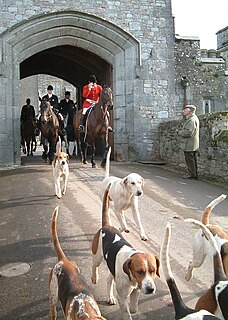
Earl of Derby is a title in the Peerage of England. The title was first adopted by Robert de Ferrers, 1st Earl of Derby, under a creation of 1139. It continued with the Ferrers family until the 6th Earl forfeited his property toward the end of the reign of Henry III and died in 1279. Most of the Ferrers property and the Derby title were then held by the family of Henry III. The title merged in the Crown upon Henry IV's accession to the throne in 1399.

Laurence Shirley, 4th Earl Ferrers was an English nobleman, notable for being the last peer to be hanged, following his conviction for murdering his steward.
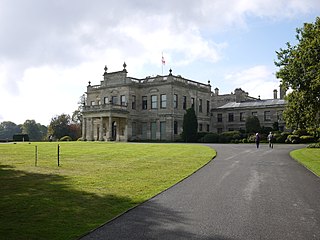
Brodsworth Hall, near Brodsworth, 5 miles (8.0 km) north-west of Doncaster in South Yorkshire, is one of the most complete surviving examples of a Victorian country house in England. It is virtually unchanged since the 1860s. It was designed in the Italianate style by the obscure London architect, Philip Wilkinson, then 26 years old. He was commissioned by Charles Sabine Augustus Thellusson, who inherited the estate in 1859. It is a Grade I listed building.
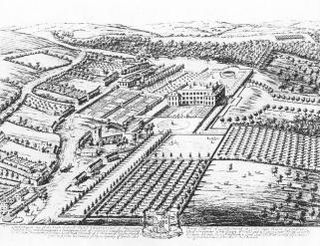
Londesborough Hall is a country house in the village of Londesborough in the East Riding of Yorkshire, England, close to the towns of Market Weighton and Pocklington.
Hothorpe Hall, in Northamptonshire, is a Georgian manor house near Market Harborough. It lies in the parish of Marston Trussell in Northamptonshire but is close to Theddingworth in Leicestershire. The hall is currently used as a conference centre and wedding venue.
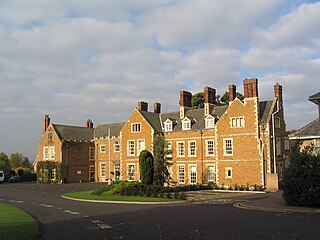
Brooksby Hall is a late–16th-century manor house on 3.2 square kilometres of land between Leicester and Melton Mowbray. Situated 13 kilometres (8.1 mi) northeast of Leicester, the hall and the neighbouring church of St Michael and All Angels are the last remnants of the medieval village of Brooksby, which was founded during the period of the Danelaw in the 9th century AD. In the 15th and 16th centuries Brooksby was depopulated by enclosures carried out by the estate's owners, which turned its cultivated land into sheep pastures in order to profit from a boom in wool.

Robert Shirley, Viscount Tamworth of Staunton Harold, Leicestershire, was an English nobleman and politician.
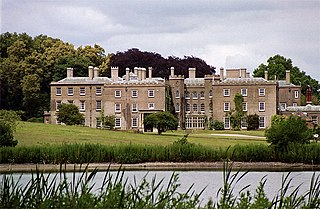
George Harry Booth-Grey, 7th Earl of Stamford and 3rd Earl of Warrington was an English cricketer, landowner and peer, who sat on the Whig benches in the House of Lords.

Vice Admiral Washington Shirley, 5th Earl Ferrers, FRS was a British Royal Navy officer, peer, freemason and amateur astronomer.

Hoar Cross Hall is a 19th-century country mansion situated near the villages of Hoar Cross and Hamstall Ridware, Staffordshire which is operated as a hotel and spa, together with facilities for conferences and weddings. It is a Grade II listed building.

Croxall Hall is a restored and extended 16th century manor house situated in the small village of Croxall, Staffordshire. It is a Grade II* listed building.

Stapleford Park is a Grade I listed country house in Stapleford, near Melton Mowbray in Leicestershire, England, which is now used as a hotel. It was originally the seat of the Sherard family, later the Earls of Harborough and, from 1894, of the Gretton family, who would become the Barons Gretton.
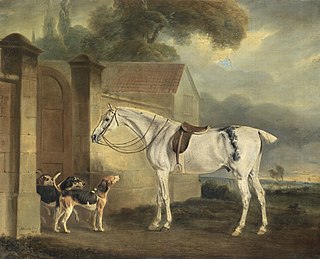
The Cottesmore Hunt, which hunts mostly in Rutland, is one of the oldest foxhound packs in Britain. Its name comes from the village of Cottesmore where the hounds were kennelled.
Quorn Hall is a grade II listed country house in the village of Quorn, Leicestershire.

Staunton Harold Hall is a large 18th-century Grade I listed country house built by the Earls Ferrers, situated within the 2,000-acre (810 ha) Staunton Harold Park in Staunton Harold, Leicestershire, England, which includes the 17th-century Grade I listed Holy Trinity Chapel.

Baggrave Hall is an 18th-century Grade II* listed country house in the parish of Hungarton, Leicestershire, UK.
Stoughton Grange was a country house in the parish of Stoughton in Leicestershire and the family seat of the Farnham and Beaumont family. The house dated back to 15th century but was demolished in 1926, after being a successful family home for over five hundred years.

Alton Towers is a former country estate located near the village of Alton in Staffordshire, England. It was a former seat of the Earls of Shrewsbury. It is now a major theme park in the United Kingdom. The area around Alton Towers has been occupied for more than a thousand years. Beginning in the Middle Ages, the site has been redeveloped several times from fortified encampment to castle and then country house. The towers are also rumoured to be haunted.
Robert Shirley, 7th Earl Ferrers FSA, styled Viscount Tamworth from 1778 to 1787, was a British nobleman.

Cold Overton Hall is a country house in the village of Cold Overton, Leicestershire, England. Built c.1664 for John St John, it is a Grade I listed building.




